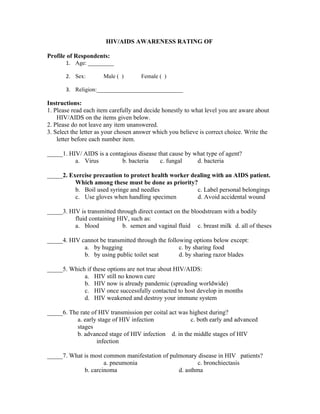
HIV/AIDS questionnaire-test your knowledge
- 1. HIV/AIDS AWARENESS RATING OF Profile of Respondents: 1. Age: _________ 2. Sex: Male ( ) Female ( ) 3. Religion:______________________________ Instructions: 1. Please read each item carefully and decide honestly to what level you are aware about HIV/AIDS on the items given below. 2. Please do not leave any item unanswered. 3. Select the letter as your chosen answer which you believe is correct choice. Write the letter before each number item. _____1. HIV/ AIDS is a contagious disease that cause by what type of agent? a. Virus b. bacteria c. fungal d. bacteria _____2. Exercise precaution to protect health worker dealing with an AIDS patient. Which among these must be done as priority? b. Boil used syringe and needles c. Label personal belongings c. Use gloves when handling specimen d. Avoid accidental wound _____3. HIV is transmitted through direct contact on the bloodstream with a bodily fluid containing HIV, such as: a. blood b. semen and vaginal fluid c. breast milk d. all of theses _____4. HIV cannot be transmitted through the following options below except: a. by hugging c. by sharing food b. by using public toilet seat d. by sharing razor blades _____5. Which if these options are not true about HIV/AIDS: a. HIV still no known cure b. HIV now is already pandemic (spreading worldwide) c. HIV once successfully contacted to host develop in months d. HIV weakened and destroy your immune system _____6. The rate of HIV transmission per coital act was highest during? a. early stage of HIV infection c. both early and advanced stages b. advanced stage of HIV infection d. in the middle stages of HIV infection _____7. What is most common manifestation of pulmonary disease in HIV patients? a. pneumonia c. bronchiectasis b. carcinoma d. asthma
- 2. _____8. Which of these are not preventive measures from HIV infection? a. Use latex condom when engage sexual intercourse b. Avoid multiple sexual partners c. Be faithful to each other d. Stay healthy by eating nutritious food. _____9. In the absence of prophylactic antiretroviral therapy to the mother during pregnancy, labor and delivery and to the fetus following birth, the probability of transmission of HIV from mother to infant/fetus in developing countries is? a. 15-25 % b. 25-35 % c. 50-60 % d. 100 % _____10. In the absence of prophylactic antiretroviral therapy to the mother during pregnancy, labor and delivery and to the fetus following birth, the probability of transmission of HIV from mother to infant/fetus in industrialized countries is ? a. 15-25 % c. 50-60 % b. 25-35 % d. 100 % _____11 .Which of the following is a mode of transmission of HIV? a. tears b. saliva c. urine d. human bite _____12. Globally which is the most common opportunistic infection in HIV-infected patients? a. mycobacterium tuberculosis c. mycobacterium avium intracellulare b. pneumocystis carinii d. toxoplasmosis _____13. Which of the following is the chief predictor of heterosexual transmission of HIV? a. duration of sexual intercourse c. genetic makeup b. plasma viremia d. presence of other Sexually transmitted diseases ______14. Which of the following is not a mode of transmission of HIV? a. sexual contact c. mosquito bite b. needle prick d. transfusion of infected fresh frozen plasma _____15. Find the false statement regarding HIV? a. Receptive intercourse by HIV infected man to woman is higher risk that HIV infected woman to man b. Higher risk of HIV infection to person with untreated sexually transmitted disease (STD). c. Oral sex is much less efficient mode of transmission of HIV than is receptive anal intercourse d. HIV infected person has same manifestation with person on stage of Acquired Immune Deficiency Syndrome (AIDS).
- 3. Questionnaire adapted and derived from: Blogsp[ot, (2009). Human Immunodeficiency Virus (HIV) MCQS: Collection of multiple choice questions on HIV and AIDS. (May 2, 2009). Retrieved from: http://hivmcqs.blogspot.com/2009/05/part-13-hiv-multiple-choice- questions.html
